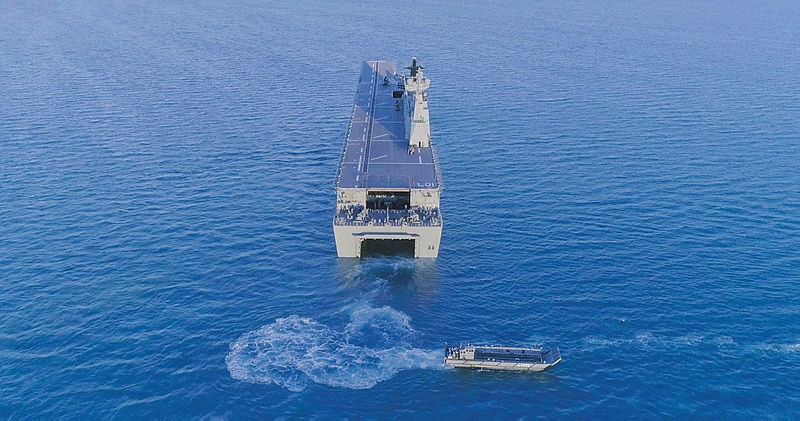
Since the mid-1970s, Australia’s defence strategy has revolved around two key principles. But as our strategic environment changes, those two guiding lights are becoming increasingly incompatible. We can decide to keep one or the other, but keeping both is untenable.
The first principle—usually described as the ‘defence of Australia’ doctrine—holds that Australia will focus its defence capability on protecting the continent from the threat of armed attack, primarily by denying the ‘sea–air gap’ to an adversary. White paper after white paper has told the almost magical story of how capabilities built for this narrow defensive requirement will also be able to achieve whatever else the government may ask of them, no matter how disparate those tasks are.
Despite the occasional reality check, and some adjustments to the wording in the 2016 white paper, this is the force we’ve built (mostly), and it’s the force we plan to continue building. It’s heavy on defensive sea denial, with more submarines and land-based fighter and attack aircraft, but light on sea control and forward presence, with fewer high-capability major surface combatants and only a small land force (though even they are justified in defensive terms). There may be some very sophisticated platforms in the mix, but the force structure is largely designed to defend the continent itself, not to help shape the strategic environment around us or to meaningfully contribute to a major conflict outside our immediate region. And it’s supposed to be able to achieve this requirement independently, without reliance on direct intervention by the US.
The second guiding light, the so-called core force concept, came into being with the Whitlam government’s ‘strategic basis’ paper of 1973 and has stubbornly stayed with us ever since. Simply put, because there was no real identifiable risk of an armed attack on the continent, the force structure could be maintained at a minimum ‘core force’ that could be ‘expanded upon in time of need’. This led to the related concept of ‘warning time’ and—zoom ahead almost 50 years and seven white papers—today’s arguments about its continued relevance in a world very different from that of the mid-1970s.
Taken together, these principles have meant that, as regional power dynamics have shifted, our ability to influence the shape of those changes has been even more limited than it otherwise would have been—a far cry from the days of the Far East Strategic Reserve and similar forward-presence initiatives. But we’re also left with a force that’s too small and too limited to stand any realistic chance of achieving its core defensive requirement against the modern Chinese military.
And the problem is even worse than it appears. Successive governments have become used to the defence of Australia and core force principles—and the reduced defence spending that goes with them—and parts of the defence establishment (most notably the air force) have used them astutely to justify certain capability procurements over others. Defence spending has been on a downward trend since the early 1970s—and especially since the 1987 white paper—while promised capabilities have never eventuated. Even after the current naval expansion is complete, we’ll still fall well short of even the ‘sixteen or seventeen’ major surface combatants promised in the 1987 white paper. Indeed, we’ll have the same number as we did when that paper was written, but with far less of a capability advantage over what our adversaries are fielding.
Expanding the core force ‘in time of need’ is now also much more difficult than it would have been 40 years ago. Huge increases in the costs of modern military technology and improved pay and conditions for personnel make it a much more expensive proposition, while the increased complexity of military systems lengthens both the lead time for major equipment and the training pipeline for personnel. It’s a wicked problem.
Clearly, it’s no longer rational to proceed with both the defence of Australia and the core force principles; the changes to the strategic environment have made that approach nonsensical. Either we stick with the defence of Australia doctrine (an approach supported by its key owner), get serious about building our own anti-access/area-denial capability and abandon the core force idea, or we maintain some version of the core force for continental defence but decide to put something in front of it—a forward presence designed to help shape the regional strategic environment in our favour and keep threats at a distance. The latter would certainly be the more efficient option; whereas capabilities designed in line with the defence of Australia doctrine aren’t easily adapted to more outward-looking strategies, the reverse isn’t true: capabilities designed to contribute in major conflicts with high levels of range and endurance would also be very valuable for continental defence.
The choice wouldn’t be an easy one, though. It would need to reflect not just defence policy, but also Australia’s view of itself as a nation and of the region in which we want to live, along with our assumptions about the nature of global affairs. Do we want to raise a defensive wall in the hope that we can somehow independently isolate our coastline from the major strategic changes affecting the world around us? Or do we want to work with others to help shape that world and ensure it remains more or less one in which we’re happy to live?
Taken individually, the defence of Australia doctrine and the core force principle are strategically dubious at best. But when they’re combined and applied to the current strategic circumstances, we find ourselves holding neither a sword nor a shield.

